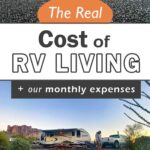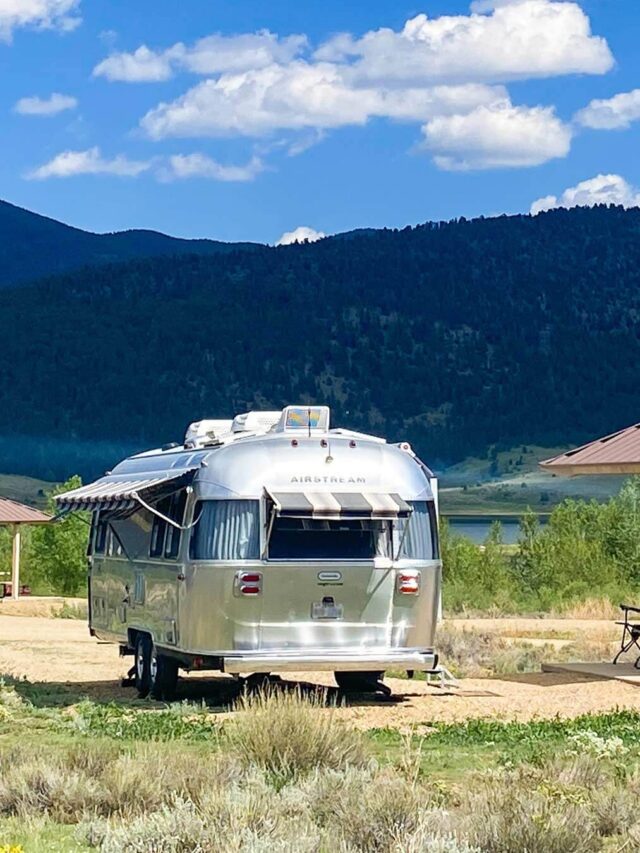The True Cost of Full Time RV Living
As an Amazon Associate, we earn from qualifying purchases. We also earn from other affiliate websites. See our full disclaimer.
Much like living in a traditional home, the cost of full-time RV living can be as expensive or as inexpensive as you want it to be. It all depends on your travel style and personal priorities.
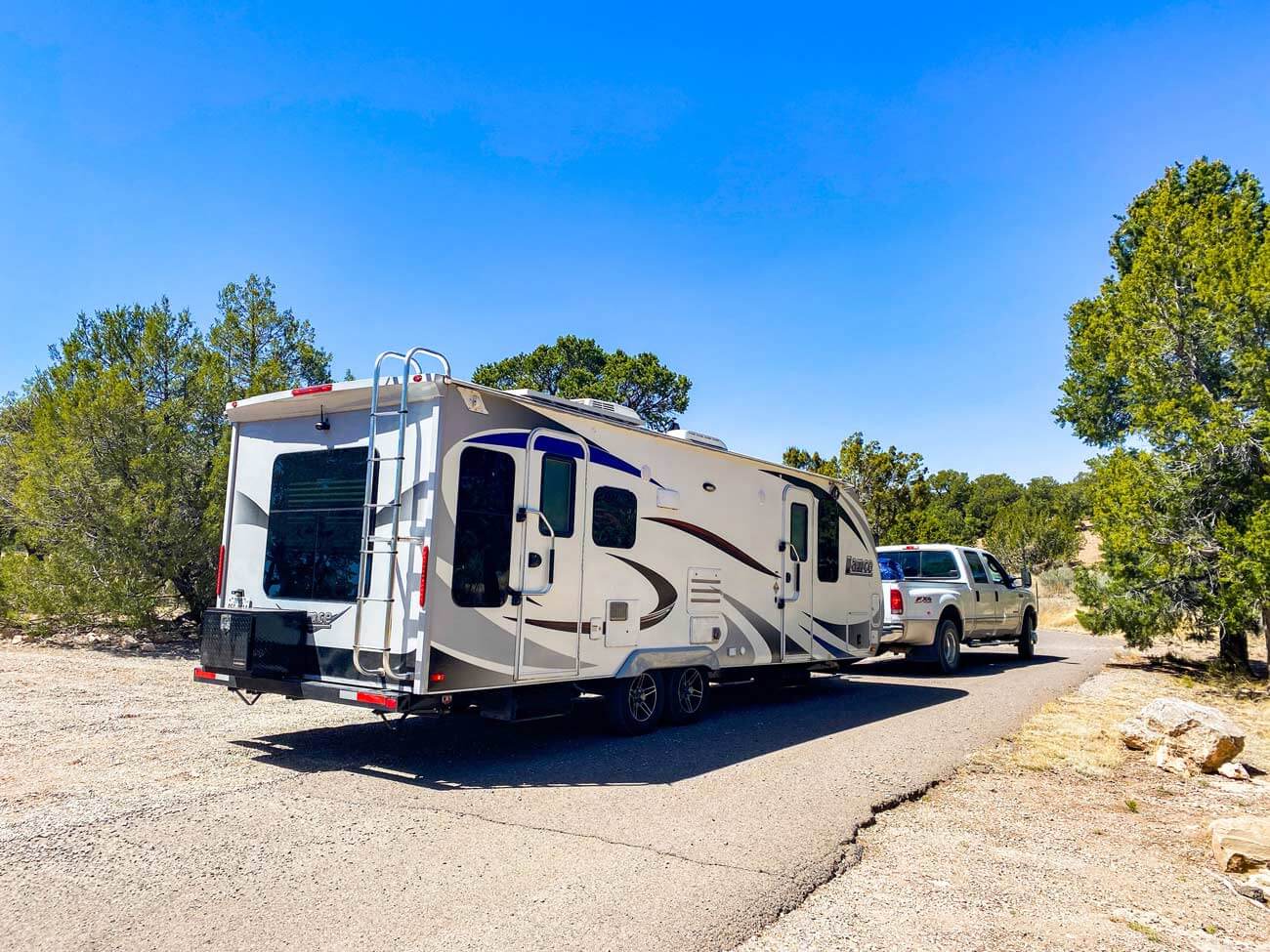
Some full-time RVers prefer to cook in their RV, enjoy free activities, and dry camp or boondock on public lands to save on campground fees.
On the opposite end of the spectrum, other campers choose to live a luxurious RV lifestyle, staying at high-end RV resorts or private campgrounds, and enjoying local cuisine daily. This can cost as much or more than a traditional sticks-and-bricks lifestyle.
Of course, many RVers live between these extremes, spending what they feel is suitable for their personal situation.
Full-time RV living costs will also vary depending on your type of RV. A fifth wheel will generally be more expensive than a travel trailer, and RV towables will likely be cheaper than a comparable motorhome. Your travel expenses will also be affected by how far you travel and how often you move.
The bottom line is that the cost of full-time RV living can vary greatly depending on your circumstances. Whether you’re just starting to create your full-time RV budget or looking for ways to trim expenses, we’ve got the cost of RVing broken down for you.
How Much Does Full-Time RV Living Cost?
Assuming you have a medium-sized RV and travel an average amount, you can expect to spend $3,000 – $5,000 per month on the cost of full-time RV living. Of course, this is a rough estimate for solo or couple RVers, and your actual costs may be higher or lower depending on your specific situation. RV families are more likely to spend in the $6,000 – 8,000 per month range.
We average around $2,880 on all our monthly expenses, detailed below. (This number was calculated on 8/15/24 and rose $180 since my calculations at the beginning of 2024).
Here are some key points on our RV living and travel style to give you an idea of what our life looks like on this budget.
- Travel style. We have big travel months, including mostly free spots, dispersed camping, or dry camping in campgrounds to save money. These are followed by stationary months of moochdocking or staying at affordable campgrounds where we can complete RV projects and catch up on work.
- RV setup. We have a smaller full-time RV (a 29-foot travel trailer from tip-to-tip) and an older truck for towing, which allows us to eliminate monthly payments from our budget and keep insurance costs low.
- Maintenance process. We DIY repairs and maintenance 90% of the time. We spend money on parts but do the labor ourselves regarding remodeling and RV and auto repair.
- Frugal lifestyle. We are always conscious of our budget and constantly look for ways to save on groceries, fuel, internet, and other expenses. If we splurge on sightseeing or entertainment in one destination, we try to find free options in the next spot.
Here is a visual breakdown of our RV living expenses over the last two years.
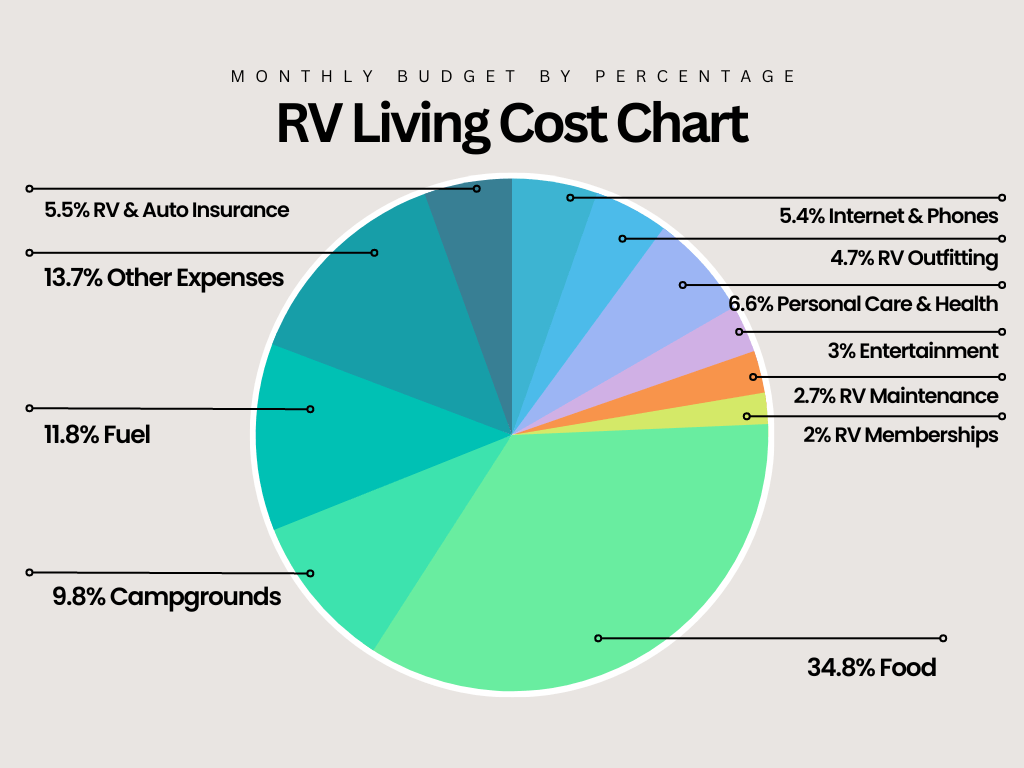
Your RV camping and travel style will greatly impact your RV budget. Below, we’ll dive further into each budget category so you can start to put together your own budget.
RV BUDGETING TOOL: When you get ready to start planning your RV budget, use our RV Living Cost Calculator to estimate your monthly costs.
To help you along your journey and be as transparent as possible, we’ve included our average monthly expenses below for each category while living in an RV.
1. RV Campsites
The cost of a campsite can range from free to over $100 per night. Most campgrounds fall into the $45 – 65 per night range.
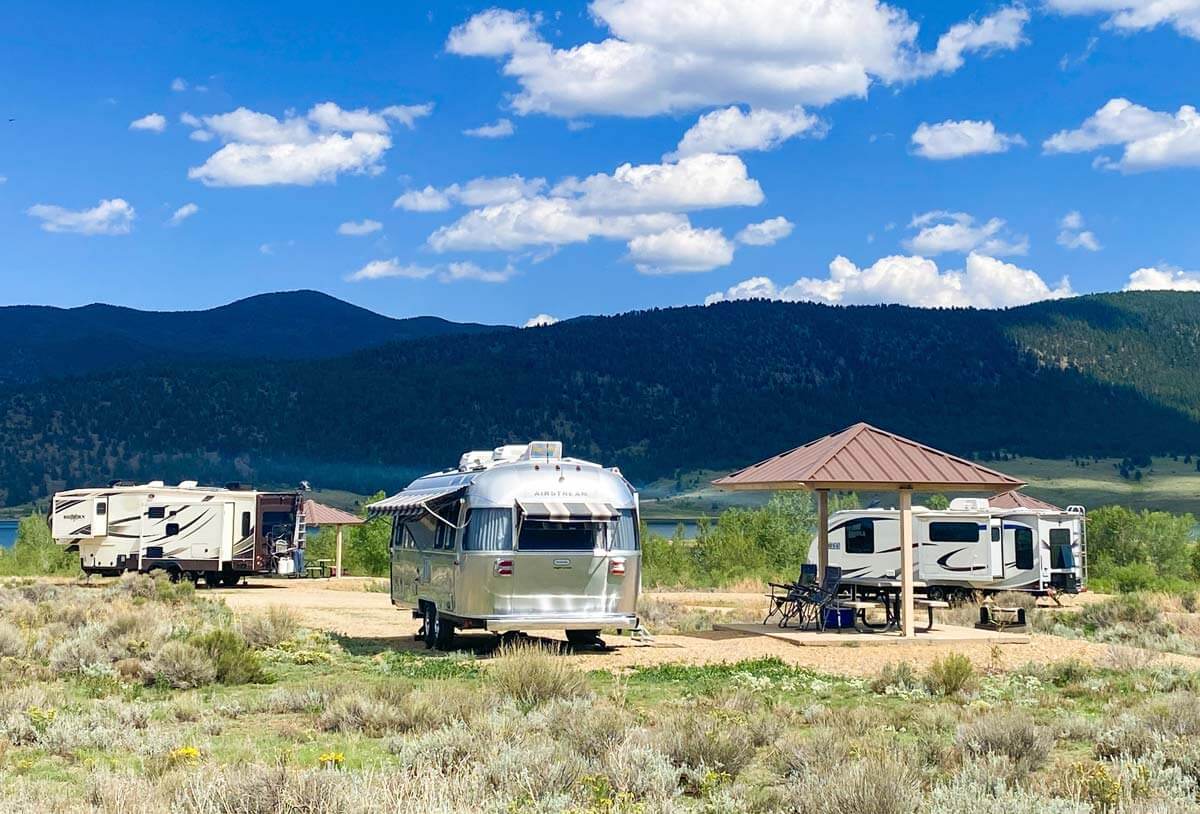
Of course, there are always exceptions. For example, state and national parks typically charge around $20-30 per night (on the east coast, this is closer to $40-60 per night), while private RV parks and resorts can charge $50-100 per night (or more).
5 Tips to Save Money on Campsites
Here are five ideas and strategies to save money on camping costs.
- Look for free or cheap campsites. Several websites and apps can help you find boondocking (wild camping) or dry camping (camping without hookups). We like Campendium (which is now being rolled into Roadtrippers) and The Dyrt. If you have solar panels and a large battery bank, you can dry camp for days or even weeks at a time.
- Join membership clubs like Passport America or Thousand Trails, which offer deeply discounted rates at participating campgrounds.
- See if the RV park offers a weekly or monthly rate. Weekly or monthly stays can save money if you plan to be in one place for an extended period.
- Research the location where you want to travel. Some areas of the country are just more expensive than others, and you’ll want to know that before you get there!
- Opt for free overnight parking on travel days. Take advantage of free overnight RV parking at Walmart, Cracker Barrel, Cabela’s, truck stops, rest stops, etc. These places will often let you stay in their parking lot overnight and are great opportunities to save money if you’re pulling in late and leaving early. (Always call ahead to ensure overnight parking is allowed at each location.)
Our Monthly Campground Costs
TOTAL: $330
*This average is mainly based on camping in the western U.S. where we opt for dry or dispersed camping 85% of the time. We camped at more expensive state parks on the East Coast during April and spent just under $1,800 on camping fees. This average excludes the months we moochdock.
2. Fuel (Gas, Diesel, Propane)
Fuel cost is one of the most significant variables regarding your RV budget. Staying in one place saves money quickly but keeps you from exploring and enjoying the RV travel lifestyle. Finding a balance is the key!

Your gas and diesel costs are impacted by the following:
- size of your RV
- frequency and length of travel days
- diesel or gas prices in the areas you plan to travel
Generally, motorhomes and trailer towing vehicles get around 10 – 12 miles per gallon. So, if gas is $3.75 per gallon and you drive 200 miles, you can expect to spend about $68 on fuel for that day. This can add up fast and become one of your biggest expenses, especially if you plan to move halfway across the country each season.
To spread out fuel costs, use our RV Gas Cost Calculator to plan your travel day fuel expenses.
Also, keep in mind that if you’re wintering in a chilly spot, your propane expenses will be much higher to run your heater. If you run a generator when you dry camp, your gas costs will also be higher.
READ NEXT: For more ways to save on fuel for your towing vehicle or RV, check out our post Discount Fuel Cards for RV Owners & How to Save at the Pump.
Propane
If you have a traditional RV fridge, it will run on propane unless you connect to shore power. Your RV stove/oven will most likely be propane as well. However, these appliances typically sip fuel. You won’t notice a massive jump in propane costs unless you’re running the RV ducted furnace.
Our Monthly Fuel Costs
Diesel: $378 (fuel for the tow truck)*
Propane: $18 (fuel for propane stove, RV fridge, and heater)
TOTAL: $396
PRO TIP: We’ll often run an electric space heater instead of our ducted propane heat if we are in a camping spot where we can connect to power.
*We average 10.3 miles per gallon in our 2003 F350 (combining towing and non-towing miles).
3. RV Maintenance and Repairs
Just like with a sticks-and-bricks home, there will be regular maintenance and occasional repairs on your RV.
Fortunately, these are usually small and easy to fix yourself if you’re handy. But every once in a while, you’ll have a more extensive repair that requires a professional.
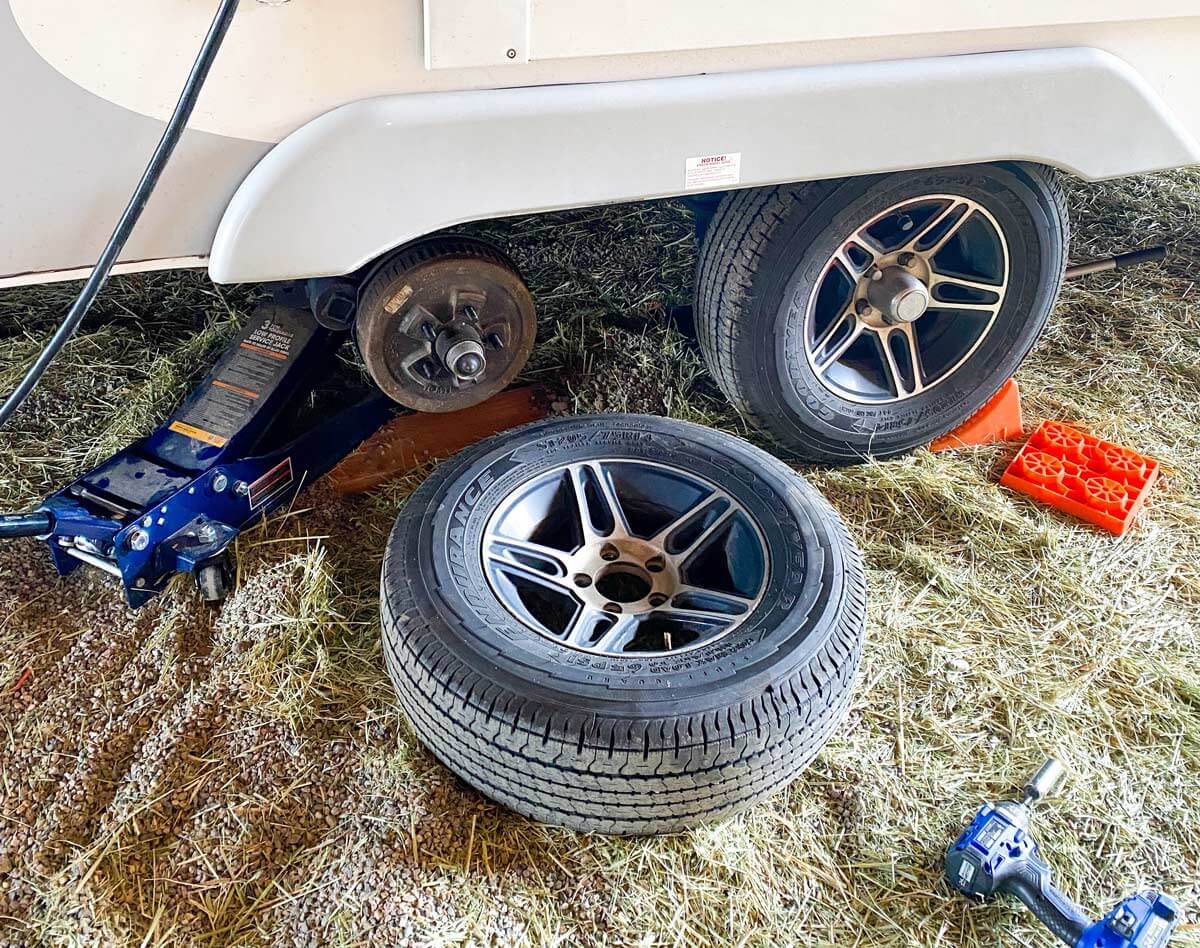
The cost of maintaining and repairing your RV is impacted by several factors:
- age of your RV
- how well the RV has been maintained
- where and when you travel
Some common maintenance and repair costs include:
- Dump Fees: $10 – 25 per dump (outside of campgrounds where you have paid to stay)
- Tire Replacement: $100 – 350 per tire
- Oil Changes: $50 – 200
- Roof Repair: $500 – 5,000
- Awning Replacement: $500 – 2,500
- Generator Service: $200 – 400
These are just some of the most common maintenance and repair costs. Of course, every RV is different, so your maintenance and repair needs may differ (and be more or less expensive).
If you have a small travel trailer, your maintenance costs will typically be on the lower end of the spectrum, while class A motorhomes will be on the highest end of RV repair. With a class C motorhome or a tow vehicle, you might be able to do some engine maintenance and repairs yourself, while large motorhomes will require you to find a professional.
Learn to DIY Repairs to Save Money
You can save money and get back on the road faster if you can DIY your RV and vehicle repairs. Even if your insurance covers a repair, you can often save part of the payout by doing the work yourself.
For example, a wind event broke our RV awning arm. Insurance covered it, and we could save money on labor since we installed it ourselves.
With another recent repair issue, the tow truck coolant was leaking. We were able to fix this with a little trial and error. We could find the parts locally in stock and didn’t need to wait to get into a repair shop, allowing us to get back on the road quickly.
Our Monthly RV Maintenance & Repair Costs
TOTAL: $104
Examples of Our Repair Costs: $1,084 for awnings and replacement parts (paid by insurance), $288 for towing (paid by insurance), $156 for truck engine parts, $74 to replace the propane regulator, $64 for parts to repair RV steps, $32 for a new jack to change tires
Examples of Our Maintenace Costs: $51 for waxing supplies, $67 for oil and filter for oil change, $73 for 303 spray protectant, $27 to weigh RV and truck, $30 for replacement hitch parts, $70 for Clearsource water filters, $5 for leveler batteries
4. RV Insurance
Insuring your RV can be costly, especially if you live in your RV full-time. Some insurance companies will not insure full-time RVers at all, while others will charge sky-high rates.
The cost of RV insurance will depend on the size of your RV, your driving record, and the coverage you choose. Expect to pay at least $500 per year for full-time RV insurance and quite possibly much more.
Our Annual RVing Insurance Costs
Auto: $888 annually / $74 monthly
RV: $1045 annually / $87 monthly*
TOTAL: $161
PRO TIP: Some insurance companies will let you combine RV and car insurance to save money. For example, both our RV and tow vehicle are insured through Progressive. However, be sure to shop around for the best deal!
*We use Progressive for full-time RV insurance and are satisfied with their service. We filed two claims, and the process went super smoothly both times.
5. RV Loan Costs
If you choose to take out a loan for your RV or tow vehicle, the loan payment will be a large part of your monthly RV budget.

Whether or not you choose to finance your RV (and other vehicles you travel with) is a personal decision that will be different for everyone based on their current financial situation, the economy, and how long you plan to keep the RV.
RVs are considered luxury items, carrying a higher interest rate than the average auto loan. For more info on RV loans, check out this article from the Nerd Wallet.
Our Monthly Auto / RV Payment Costs
TOTAL: $0
6. Food
The cost of food is one of the more predictable expenses in your RV monthly budget since it likely won’t change from what you currently do.

Your eating habits tend to stay the same when you RV full-time. If you like eating out or grabbing a “treat” when you’re out and about, chances are, you’ll still do that when you RV full-time.
Remember eating out is also part of the travel experience, so make room for those costs in your budget.
One thing to note is traveling full-time might require stocking up on specialty items. This will lead your food budget to fluctuate more month to month.
For example, we order meal replacement shakes in bulk whenever we are in a spot where it’s easy to receive shipments. We usually stock up every other month.
Our Monthly Food Costs
Groceries: $394
Restaurants: $342
Other Food: $83 (gas station stops, coffees, bakeries, specialty items, etc.)
Alcohol / Night Out: $84
TOTAL: $903
7. Entertainment
The cost of entertainment will be different for everyone and typically varies from month to month.
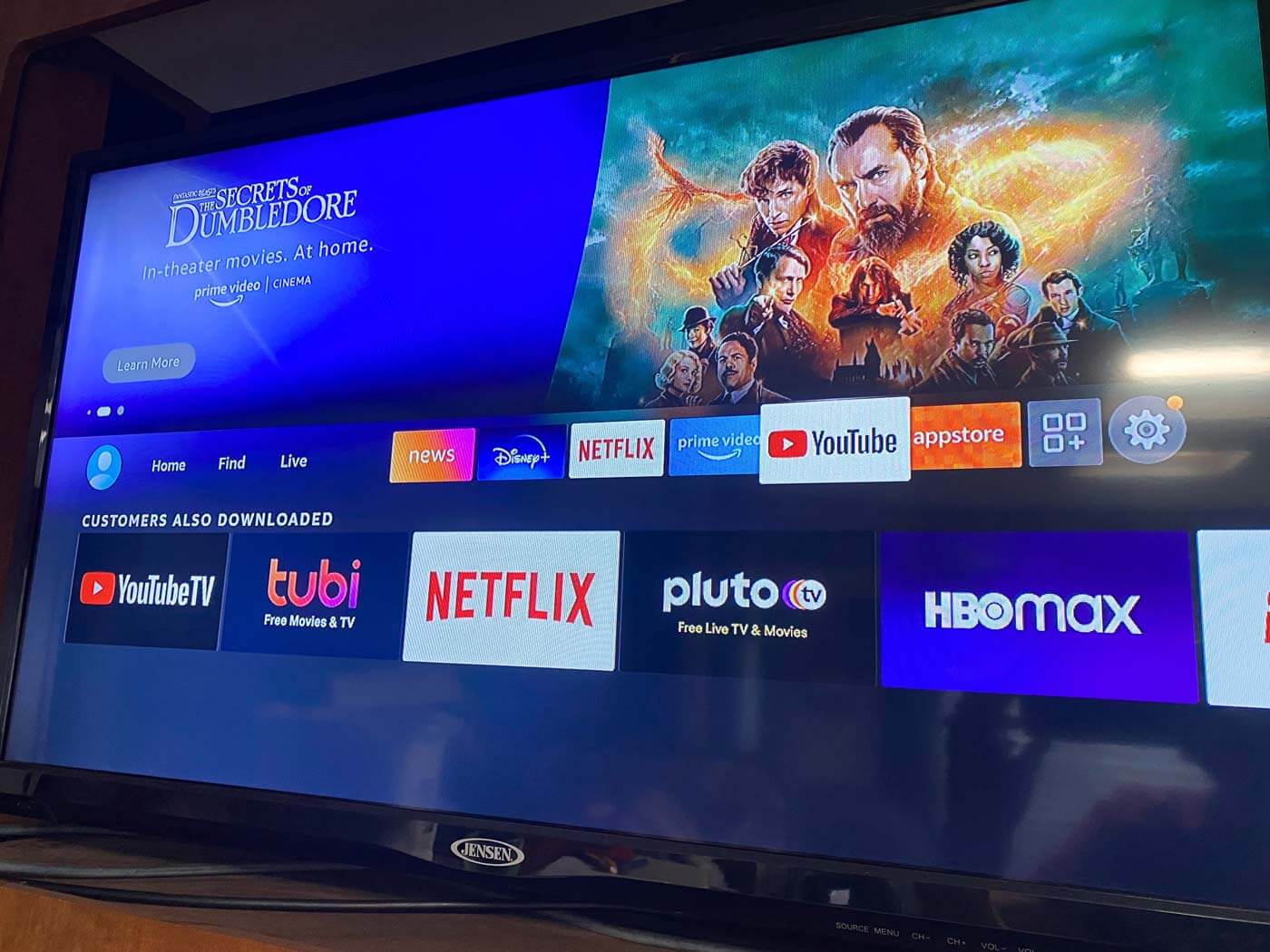
In this category, we include things like:
- museums and tours
- sightseeing (entry fees, parking, etc.)
- movies
- concerts
- other activities (theme parks, outdoor activities, parasailing, etc.)
Also included are any monthly recurring or one-time costs for:
- streaming music
- streaming movies
- audiobook membership
- digital purchases for movies and books
There are endless free ways to entertain yourself while living in an RV. However, you’ll want to allocate some budget here for paid experiences. Some months might be low-cost, while others will include a splurge for a particular activity.
Our Entertainment Costs
Sightseeing: $39
Movies & Concerts: $25
Music & Video Streaming: $15.17 (YouTube Premium)
Other Digital Purchases: $0 (paid with Amazon digital credits)
Firewood: $12*
TOTAL: $91.17
*We also include firewood (which can add up fast) under this budget category. It definitely contributes to the fun factor when camping!
**We recently canceled Audible because we had a huge backlog of books we hadn’t listened to, but we do love it for traveling.
8. Internet
If you plan to work while living in your RV or just want to stay connected while on the road, you’ll need some form of internet and cell phone service.
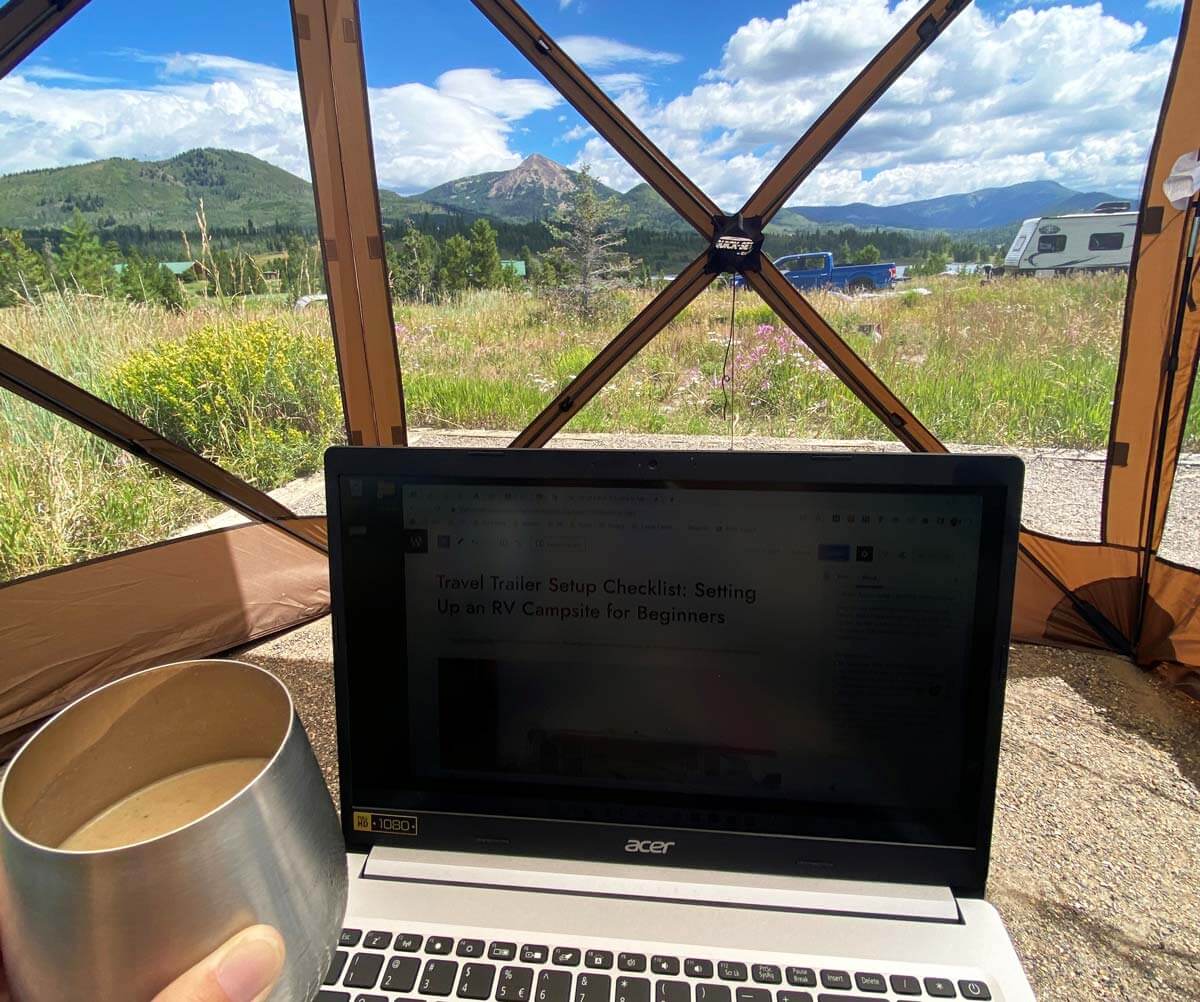
Remote work will require multiple data plans to ensure a connection and will drive up the monthly cost of your internet service. You may also want a satellite internet connection such as Starlink if you plan to RV in places with limited cellular coverage.
However, if you don’t need internet for work, you may use only your phone’s hotspot or stay in places that offer free WiFi to save money.
You’ll also need to consider one-time costs to get up and running. If you’re going to install a mobile internet router with an antenna to boost your data signal and manage multiple data plans, that will cost $650 to $1,200.
Our Monthly Internet Costs
Phone Plan: $60 (two mobile unlimited plans on Visible)
RV Mobile Router: $55 (AT&T 100GB prepaid data plan)
TOTAL: $115
NOTE: We previously also had a Visible plan for the mobile router but have recently stopped using it since we find we can typically utilize our phones as hotspots.
9. Campground Memberships, Passes, and Apps
Camping memberships are a great way to save money while RVing. Once you figure out your camping style, you can decide if you want to invest in campground memberships, park passes, or a combination.
Here are a few different options to consider:
- Thousand Trails and Passport America are two of the most popular memberships. Both of these memberships offer discounts at participating campgrounds. (Here is a great article to learn more about the benefits of Passport America.)
- Harvest Hosts and Boondockers Welcome are memberships made possible by private businesses and residences that allow you to camp overnight on their property. To learn more, check out our post An Honest Harvest Hosts Review: Is It Worth It?
- State parks might offer camping deals with their passes (check each state park’s website for details).
- America the Beautiful Pass offers free entry into National Parks and discounts on select national forest camping spots around the country.
As mentioned earlier, camping apps like Campendium and The Dyrt are also excellent sources for searching and filtering for discount camping options.
Our Annual RV Memberships, Passes, and Apps
State Park Passes: $70, $40 (Texas, Michigan)
National Park Pass (American the Beautiful): $80
Good Sam: $29
The Dyrt Pro App: $35.99
Roadpass Pro App: $59.99
All Trails Pro App: $29.99
My Radar App: $21.44
TOTAL: $30.53 per month
NOTE: If your camping style leans toward campgrounds, this budget category may look different. You’ll most likely want memberships like Thousand Trails and Passport America to keep costs down.
10. Other RV Monthly Expenses
Several other miscellaneous costs can add up when you’re RVing full-time.
Some of these costs won’t change much from your average home costs, such as personal care and clothing costs. However, items like laundry, health insurance, and even pet expenses can change a bit on the road.
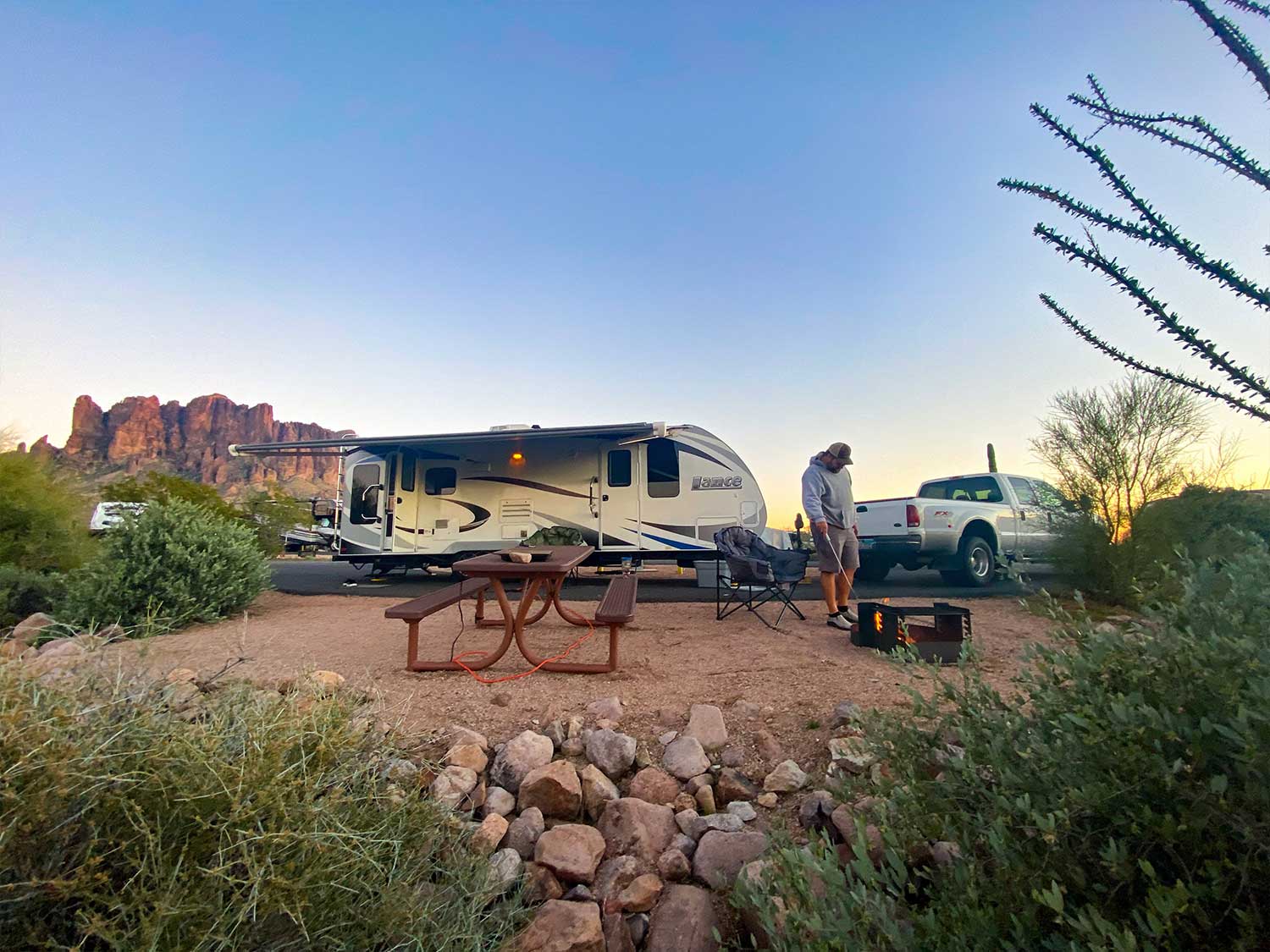
Laundry costs can add up while RVing. Doing laundry while living in an RV can be a challenge. Some campgrounds have on-site laundry facilities that you can use for a fee. However, these can be expensive, with average costs of $4-6 per load. If you have a large RV, you might want to install a washer/dryer combo unit.
We cut costs by doing small washes in a collapsible tub or a Scrubba wash bag and investing in Merino wool or quality synthetics with antimicrobial priorities for odor control.
Health insurance is another fixed expense that can be different while on the road. If you have a health plan through your employer, you may be able to continue that coverage while traveling. However, check with your insurance provider to ensure you’re still covered while away from home.
You may also consider a healthcare-sharing plan like Liberty Healthshare or Samaritan Ministries.
Depending on your full-time RVing situation, you may also need to consider additional expenses for mail forwarding or a storage unit.
Our Other Misc. Costs
Laundry: $12
Clothing: $42
Souvenirs: $57
RV Outfitting: $80 (projects, new items, and add-ons for the RV)
Personal Care: $96 (personal care items, haircuts, etc.)
Health & Dental: $217
Pet Expenses: $136 (vet fees, insurance, GPS tracker fee, food, etc.)
Amazon Prime: $11 ($132 annually)
iPhone Cloud Storage: $10 monthly
Travel Memberships with Credit Cards: $21 ($252 annually)*
Other: $68 (electronics, gifts, and other purchases)
TOTAL: $750
*Travel memberships include multiple credit card annual fees that we use for travel hacking, earning points, etc. We enjoyed $2,474 worth of hotel, air, and other purchases with these programs in 2023.
Total Cost of RV Living
The overall cost of full-time RVing can vary widely, depending on the factors above. A couple who lives in a small RV and travels slower will have much lower expenses than a family of four who lives in a large RV and travels frequently.

Your Guide to Launching RV Life
Road Map & Checklist – Start Now!
Unsubscribe at any time. View our privacy policy.
It’s important to remember that RV living costs are just one part of the equation. The other side of the coin is the lifestyle itself.
For many people, the freedom and flexibility that comes with RVing are priceless. So, even if it costs a bit more than living in a house or apartment, the RV lifestyle can still be worth it.
Only you can decide if RVing is the right choice for you!
I hope this breakdown gives you a better idea of the cost of full-time RV living and some of the best ways to save on additional costs. Please comment below if you have any questions or want to share your experience RVing on a budget.
Want to learn more about how to go full-time RVing on a budget?
Find more tips for RV living on the cheap, including finding deals on campsites, calculating your fuel cost, and more – view our complete guide.
Like this post? Save it on Pinterest for later.
Or view our web story.

